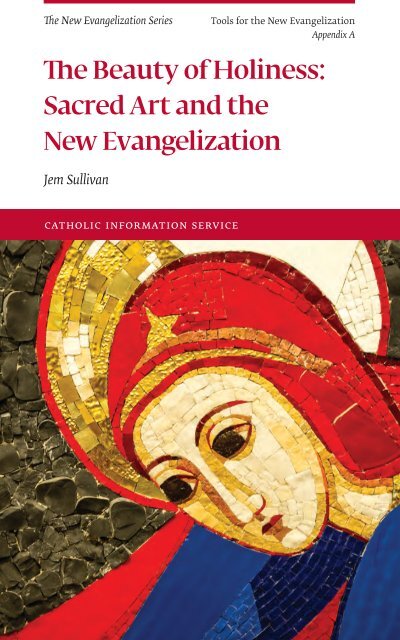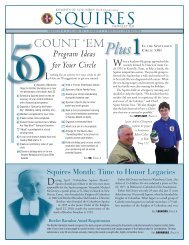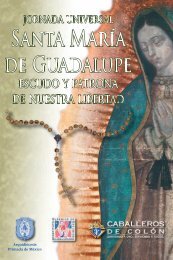Sacred Art and the New Evangelization - Knights of Columbus ...
Sacred Art and the New Evangelization - Knights of Columbus ...
Sacred Art and the New Evangelization - Knights of Columbus ...
You also want an ePaper? Increase the reach of your titles
YUMPU automatically turns print PDFs into web optimized ePapers that Google loves.
The <strong>New</strong> <strong>Evangelization</strong> Series<br />
Tools for <strong>the</strong> <strong>New</strong> <strong>Evangelization</strong><br />
Appendix A<br />
The Beauty <strong>of</strong> Holiness:<br />
<strong>Sacred</strong> <strong>Art</strong> <strong>and</strong> <strong>the</strong><br />
<strong>New</strong> <strong>Evangelization</strong><br />
Jem Sullivan<br />
catholic information service
general editor<br />
Michelle K. Borras, Ph.D.<br />
Director <strong>of</strong> <strong>the</strong> Catholic<br />
Information Service<br />
photography<br />
Thomas Serafin<br />
© Copyright 2012, <strong>Knights</strong> <strong>of</strong> <strong>Columbus</strong>.<br />
All rights reserved.<br />
Quoted works are copyright <strong>the</strong>ir respective<br />
authors.<br />
Scripture citations adapted from <strong>the</strong><br />
Revised St<strong>and</strong>ard Version, Catholic Edition<br />
(San Francisco: Ignatius, 1994).<br />
nihil obstat<br />
Susan M. Timoney, S.T.D.<br />
Censor Deputatus<br />
imprimatur<br />
Donald Cardinal Wuerl<br />
Archbishop <strong>of</strong> Washington<br />
Archdiocese <strong>of</strong> Washington<br />
September 4, 2012<br />
The nihil obstat <strong>and</strong> imprimatur are <strong>of</strong>ficial<br />
declarations that a book or pamphlet is<br />
free <strong>of</strong> doctrinal or moral error. There is no<br />
implication that those who have granted<br />
<strong>the</strong> nihil obstat <strong>and</strong> <strong>the</strong> imprimatur agree<br />
with <strong>the</strong> content, opinions, or statements<br />
expressed <strong>the</strong>rein.<br />
cover image<br />
Detail <strong>of</strong> <strong>the</strong> Virgin Mary bending over <strong>the</strong> infant Christ. From <strong>the</strong> Wall<br />
<strong>of</strong> <strong>the</strong> Nativity, Chapel <strong>of</strong> <strong>the</strong> Holy Family, <strong>Knights</strong> <strong>of</strong> <strong>Columbus</strong> Supreme<br />
Council, <strong>New</strong> Haven Connecticut. The chapel mosaics were completed by<br />
Fr. Marko Ivan Rupnik, SJ <strong>and</strong> <strong>the</strong> artists <strong>of</strong> Centro Aletti in 2005.
The Beauty <strong>of</strong> Holiness:<br />
<strong>Sacred</strong> <strong>Art</strong> <strong>and</strong> <strong>the</strong> <strong>New</strong> <strong>Evangelization</strong><br />
Jem Sullivan
Contents<br />
From Seeing to Contemplation to Adoration<br />
2 From <strong>the</strong> Visible to <strong>the</strong> Invisible<br />
4 Seeing with <strong>the</strong> “Eyes <strong>of</strong> Faith”<br />
5 The Challenge <strong>of</strong> a “Sensory Dissonance”<br />
Four Reasons to Place <strong>Sacred</strong> <strong>Art</strong> at <strong>the</strong> Service<br />
<strong>of</strong> <strong>the</strong> <strong>New</strong> <strong>Evangelization</strong><br />
9 Jesus Christ, <strong>the</strong> Icon <strong>of</strong> God<br />
10 The Witness <strong>of</strong> Christian <strong>Art</strong> History<br />
11 Responding to <strong>the</strong> Beauty <strong>of</strong> Faith<br />
13 A “Culture <strong>of</strong> Images” <strong>and</strong> <strong>the</strong> <strong>New</strong> <strong>Evangelization</strong><br />
Toward ano<strong>the</strong>r Way <strong>of</strong> Seeing<br />
15 Awakening <strong>the</strong> Spiritual Senses<br />
17 Lectio Divina Adapted to <strong>Art</strong> at <strong>the</strong> Service<br />
<strong>of</strong> <strong>the</strong> <strong>New</strong> <strong>Evangelization</strong><br />
20 Purifying <strong>the</strong> Senses for God<br />
22 The Beauty <strong>of</strong> Holiness<br />
24 Sources<br />
26 About
Detail <strong>of</strong> St. Joseph, sleeping.<br />
Wall <strong>of</strong> <strong>the</strong> Nativity, Chapel <strong>of</strong> <strong>the</strong> Holy Family.<br />
<strong>Knights</strong> <strong>of</strong> <strong>Columbus</strong> Supreme Council,<br />
<strong>New</strong> Haven, Connecticut.
From Seeing<br />
to Contemplation<br />
to Adoration<br />
Pope Benedict XVI has called attention to <strong>the</strong> relevance <strong>of</strong><br />
sacred art for <strong>the</strong> new evangelization on numerous occasions.<br />
One such occasion was <strong>the</strong> presentation <strong>of</strong> <strong>the</strong> Compendium<br />
<strong>of</strong> <strong>the</strong> Catechism <strong>of</strong> <strong>the</strong> Catholic Church to <strong>the</strong> universal<br />
Church. The Compendium, among <strong>the</strong> first publications <strong>of</strong> this<br />
pontificate, contains some fourteen works <strong>of</strong> sacred art. In<br />
introducing <strong>the</strong> Compendium, <strong>the</strong> Holy Fa<strong>the</strong>r noted, “Works<br />
<strong>of</strong> art always ‘speak,’ at least implicitly, <strong>of</strong> <strong>the</strong> divine, <strong>of</strong> <strong>the</strong><br />
infinite beauty <strong>of</strong> God…. <strong>Sacred</strong> images, with <strong>the</strong>ir beauty,<br />
are also a Gospel proclamation <strong>and</strong> express <strong>the</strong> splendor <strong>of</strong><br />
<strong>the</strong> Catholic truth…. They urge one <strong>and</strong> all, believers <strong>and</strong><br />
non-believers alike, to discover <strong>and</strong> contemplate <strong>the</strong> inexhaustible<br />
fascination <strong>of</strong> <strong>the</strong> mystery <strong>of</strong> Redemption, giving<br />
an ever new impulse to <strong>the</strong> lively process <strong>of</strong> its inculturation<br />
in time.” 1<br />
As <strong>the</strong> Church reflects on <strong>the</strong> call <strong>and</strong> <strong>the</strong> challenges <strong>of</strong><br />
<strong>the</strong> new evangelization, we are invited to reflect anew on<br />
<strong>the</strong> relationship <strong>of</strong> sacred art to evangelization <strong>and</strong> catechesis.<br />
What is <strong>the</strong> catechetical value <strong>of</strong> sacred images?<br />
How might sacred art serve to aid formation in <strong>the</strong> con-<br />
1
tent <strong>of</strong> Christian faith? And might artistic masterpieces<br />
serve as powerful tools <strong>of</strong> <strong>the</strong> new evangelization in our<br />
own day <strong>and</strong> age?<br />
From <strong>the</strong> Visible to <strong>the</strong> Invisible<br />
The Catechism <strong>of</strong> <strong>the</strong> Catholic Church notes that sacred art “is<br />
true <strong>and</strong> beautiful when its form corresponds to its particular<br />
vocation: evoking <strong>and</strong> glorifying, in faith <strong>and</strong> adoration,<br />
<strong>the</strong> transcendent mystery <strong>of</strong> God – <strong>the</strong> surpassing invisible<br />
beauty <strong>of</strong> truth <strong>and</strong> love visible in Christ, who ‘reflects<br />
<strong>the</strong> glory <strong>of</strong> God <strong>and</strong> bears <strong>the</strong> very stamp <strong>of</strong> his nature,’ in<br />
whom ‘<strong>the</strong> whole fullness <strong>of</strong> deity dwells bodily…. Genuine<br />
sacred art draws man to adoration, to prayer <strong>and</strong> to <strong>the</strong> love<br />
<strong>of</strong> God, Creator <strong>and</strong> Savior, <strong>the</strong> Holy One <strong>and</strong> Sanctifier.’ 2<br />
It follows that <strong>the</strong> role <strong>of</strong> sacred art in <strong>the</strong> new evangelization<br />
is to lead <strong>the</strong> faithful from seeing to contemplation to<br />
adoration <strong>of</strong> God. For as Pope Benedict XVI has noted, great<br />
works <strong>of</strong> art “are all a luminous sign <strong>of</strong> God <strong>and</strong> <strong>the</strong>refore<br />
truly a manifestation, an epiphany <strong>of</strong> God.” 3 A sacred<br />
image <strong>of</strong> Christ, <strong>the</strong> Blessed Virgin Mary, Mo<strong>the</strong>r <strong>of</strong> God, or<br />
a Christian saint provides an earthly glimpse into eternal<br />
realities, a “head start to heaven,” so to speak.<br />
The Catechism describes <strong>the</strong> goal <strong>of</strong> liturgical catechesis<br />
(mystagogy) as initiation into <strong>the</strong> mystery <strong>of</strong> Christ by proceeding<br />
from <strong>the</strong> visible to <strong>the</strong> invisible, from <strong>the</strong> sign to<br />
<strong>the</strong> thing signified, from <strong>the</strong> ‘sacraments’ to <strong>the</strong> ‘mysteries.’”<br />
4 Instituted by Christ, <strong>the</strong> sacraments are <strong>the</strong> privileged<br />
means by which <strong>the</strong> faithful participate in his saving mys-<br />
2
tery through <strong>the</strong> ministry <strong>of</strong> <strong>the</strong> Church. Within this sacramental<br />
economy, sacred art that predisposes one to <strong>the</strong><br />
sacramental presence <strong>of</strong> God may serve as a pre-sacrament, a<br />
phrase used by Blessed John Paul II to describe <strong>the</strong> sacred<br />
art <strong>and</strong> architecture <strong>of</strong> <strong>the</strong> Sistine Chapel.<br />
To limit <strong>the</strong> function <strong>of</strong> sacred images to mere decorative<br />
or aes<strong>the</strong>tic representations <strong>of</strong> socio-cultural ideals,<br />
as is <strong>of</strong>ten <strong>the</strong> case, is to miss a high note in <strong>the</strong> liturgical<br />
symphony composed <strong>of</strong> sacred images, architecture,<br />
music <strong>and</strong> rites. <strong>Sacred</strong> images obviously express human,<br />
social, <strong>and</strong> cultural realities, <strong>and</strong> <strong>the</strong>y add aes<strong>the</strong>tic value<br />
to <strong>the</strong> interior <strong>and</strong> exterior spaces <strong>of</strong> ca<strong>the</strong>drals, chapels<br />
<strong>and</strong> churches. But sacred images are also an indispensable<br />
means to instruct <strong>the</strong> faithful in <strong>the</strong> content <strong>of</strong> divine revelation,<br />
<strong>and</strong> reawaken <strong>and</strong> nourish <strong>the</strong>ir faith. With <strong>the</strong> help<br />
<strong>of</strong> sacred art, catechists, preachers <strong>and</strong> teachers <strong>of</strong> faith echo<br />
<strong>the</strong> divine pedagogy <strong>of</strong> salvation history wherein <strong>the</strong> witness<br />
<strong>of</strong> God’s “words” <strong>and</strong> “deeds” are inextricably linked.<br />
Blessed John Paul II drew attention to <strong>the</strong> pedagogical<br />
value <strong>of</strong> sacred images in his 1999 Letter to <strong>Art</strong>ists when he<br />
wrote, “In a sense, art is a kind <strong>of</strong> visual Gospel, a concrete<br />
mode <strong>of</strong> catechesis.” 5 Which is to say that each Sunday, as<br />
<strong>the</strong> faithful hear <strong>the</strong> truth <strong>of</strong> <strong>the</strong> Gospel proclaimed <strong>and</strong><br />
respond by pr<strong>of</strong>essing <strong>the</strong>ir faith in <strong>the</strong> Creed, those same<br />
truths <strong>of</strong> faith are revealed in <strong>the</strong> sacred art that surround<br />
<strong>the</strong>m. Church teachings <strong>and</strong> doctrines condensed onto a<br />
page <strong>of</strong> a Catechism find complementary forms <strong>of</strong> expression<br />
in sacred art <strong>and</strong> architecture. In this way, sacred art<br />
– paintings, mosaics, stained glass, sculpture, sacred music<br />
3
– become a “visual Gospel,” by which <strong>the</strong> faithful see, hear,<br />
<strong>and</strong> touch <strong>the</strong> mysteries <strong>of</strong> faith so as to incarnate its truths<br />
in holiness <strong>of</strong> life <strong>and</strong> Christian witness.<br />
Seeing with <strong>the</strong> “Eyes <strong>of</strong> Faith”<br />
One <strong>of</strong> <strong>the</strong> first to affirm this role <strong>of</strong> sacred images was<br />
Pope Saint Gregory <strong>the</strong> Great. In a letter to Serenus, Bishop<br />
<strong>of</strong> Marseilles in AD 599, he wrote, “Painting is employed<br />
in churches so that those who cannot read or write may at<br />
least read on <strong>the</strong> walls what <strong>the</strong>y cannot decipher on <strong>the</strong><br />
page.” 6 The movement from seeing to contemplation to adoration<br />
<strong>of</strong> God is realized through written or spoken words <strong>and</strong><br />
through sacred images.<br />
For centuries sacred images were created with catechesis<br />
in mind. Of course, <strong>the</strong> appropriation <strong>of</strong> signs <strong>and</strong> symbols<br />
in sacred images relied on effective preaching <strong>and</strong> teaching<br />
in communion with <strong>the</strong> “seeing faith <strong>of</strong> <strong>the</strong> Church.”<br />
But <strong>the</strong> whole pedagogical point <strong>of</strong> a sacred image is not to<br />
engage viewers in an intellectual or didactic exercise alone.<br />
It is to lead <strong>the</strong>m to awe <strong>and</strong> wonder, perhaps even to a<br />
ravishing <strong>of</strong> <strong>the</strong> soul by a glimpse <strong>of</strong> divine beauty, in <strong>the</strong><br />
hope that <strong>the</strong>y entrust <strong>the</strong>ir lives to this beauty <strong>and</strong> pursue<br />
a life <strong>of</strong> holiness. As <strong>the</strong> Preface for Christmas (I) reads,<br />
“In <strong>the</strong> mystery <strong>of</strong> <strong>the</strong> Word made flesh a new light <strong>of</strong> your<br />
glory has shone upon <strong>the</strong> eyes <strong>of</strong> our mind, so that, as we<br />
recognize in him God made visible, we may be caught up<br />
through him in love <strong>of</strong> things invisible.”<br />
4
The whole point is to lead <strong>the</strong> faithful to perceive <strong>the</strong><br />
Invisible in <strong>the</strong> visible, to learn a new way <strong>of</strong> seeing <strong>and</strong><br />
hearing that leads to contemplation, worship <strong>and</strong> adoration<br />
<strong>of</strong> God. In this way, sacred art serves <strong>the</strong> new evangelization<br />
for <strong>the</strong> transmission <strong>of</strong> <strong>the</strong> Christian faith in our time.<br />
Pope Gregory’s assertion, cited above, would take distinct<br />
visible form in <strong>the</strong> outpouring <strong>of</strong> Christian art <strong>and</strong> architecture<br />
during <strong>the</strong> Middle Ages. A Gothic ca<strong>the</strong>dral, such<br />
as Chartres ca<strong>the</strong>dral, served, in effect, as a “catechism in<br />
stone,” a homily in stained glass, expressing for <strong>the</strong> faithful<br />
in art <strong>and</strong> architecture <strong>the</strong> faith <strong>the</strong>y pr<strong>of</strong>essed in <strong>the</strong><br />
Creed <strong>and</strong> heard proclaimed in <strong>the</strong> Scriptures. As medieval<br />
craftsmen set stone upon carved stone in a building visible<br />
from miles away <strong>and</strong> luminous through colored glass, <strong>the</strong>y<br />
were, in fact, sculpting <strong>and</strong> painting <strong>the</strong> saving message <strong>of</strong><br />
biblical history – explicit <strong>and</strong> beautiful as <strong>the</strong>ir faith. Thus<br />
a pilgrim entering Chartres ca<strong>the</strong>dral was drawn into a<br />
“reading” <strong>of</strong> past biblical history made visible in its sacred<br />
art <strong>and</strong> architecture. At <strong>the</strong> same time, he was inserted<br />
through his seeing <strong>and</strong> hearing into a sacramental present,<br />
fully realized in <strong>the</strong> liturgy.<br />
The Challenge <strong>of</strong> a “Sensory Dissonance”<br />
Over <strong>the</strong> Christian centuries, sacred art served as a means<br />
<strong>of</strong> evangelization as it expressed, communicated <strong>and</strong> nourished<br />
<strong>the</strong> faith <strong>of</strong> Christians. In ages past, moments from<br />
<strong>the</strong> life <strong>of</strong> Christ, <strong>the</strong> Virgin Mary, <strong>the</strong> saints, <strong>and</strong> biblical<br />
events <strong>and</strong> figures were an unending source <strong>of</strong> inspiration<br />
5
for art, architecture, music <strong>and</strong> literature. In <strong>the</strong> words <strong>of</strong><br />
Blessed John Paul II, “<strong>Sacred</strong> Scripture thus became a sort <strong>of</strong><br />
‘immense vocabulary’ (Paul Claudel) <strong>and</strong> an ‘iconographic<br />
atlas’ (Marc Chagall) from which both Christian culture<br />
<strong>and</strong> art have drawn.” 7<br />
Today <strong>the</strong> sacred artistic heritage <strong>of</strong> <strong>the</strong> West barely resonates<br />
in <strong>the</strong> common religious imagination. The visual<br />
deposit <strong>of</strong> faith in Christian art has only a negligible place<br />
in pastoral planning, liturgy, catechesis <strong>and</strong> evangelization.<br />
For younger generations <strong>the</strong> loss <strong>of</strong> familiarity <strong>and</strong> ready<br />
access to <strong>the</strong> Christian tradition <strong>of</strong> sacred art is particularly<br />
real. Born <strong>and</strong> educated in <strong>the</strong> so-called Information Age<br />
<strong>and</strong> immersed in internet <strong>and</strong> communications technologies,<br />
young people instantly recognize images <strong>and</strong> sounds<br />
from popular movies, music, commercials <strong>and</strong> advertizing.<br />
Unlike previous generations, <strong>the</strong>y are saturated, consciously<br />
<strong>and</strong> unconsciously, with values conveyed through <strong>the</strong> visual<br />
<strong>and</strong> sensory culture that surrounds <strong>the</strong>m. We have even<br />
begun to speak <strong>of</strong> “sensory overload” <strong>and</strong> “sensory addictions”<br />
in those immersed in today’s media culture.<br />
As we respond to <strong>the</strong> call for a new evangelization, we<br />
are led to wonder – could not <strong>the</strong> vast heritage <strong>of</strong> Christian<br />
art <strong>and</strong> <strong>the</strong> beauty <strong>of</strong> holiness it expresses in sensory forms<br />
also shape <strong>and</strong> influence <strong>the</strong>se generations?<br />
We are also led to consider a striking paradox that remains<br />
a challenge for <strong>the</strong> new evangelization. This paradox takes<br />
<strong>the</strong> form <strong>of</strong> a sensory dissonance that marks <strong>the</strong> relationship <strong>of</strong><br />
Christian art to contemporary culture. The diminishing role<br />
<strong>and</strong> place <strong>of</strong> Christian art in liturgy, catechesis <strong>and</strong> evange-<br />
6
lization has occurred precisely at <strong>the</strong> moment when popular<br />
media culture, in content <strong>and</strong> medium, has become<br />
increasingly sensory <strong>and</strong> visual. Everyday life is infused with<br />
images, words <strong>and</strong> sounds aimed at engaging <strong>the</strong> mind, will,<br />
senses <strong>and</strong> emotions, while <strong>the</strong> daily or weekly experience<br />
<strong>of</strong> liturgy, catechesis <strong>and</strong> evangelization is <strong>of</strong>ten bereft <strong>of</strong><br />
beauty. While <strong>the</strong> surrounding culture appeals constantly<br />
to visual <strong>and</strong> sensory experiences, <strong>the</strong> place <strong>and</strong> role <strong>of</strong> sensory<br />
expressions <strong>of</strong> faith within <strong>the</strong> Christian community<br />
have decreased significantly.<br />
This sensory dissonance <strong>of</strong>fers one among many challenges<br />
for <strong>the</strong> new evangelization. For clearly <strong>the</strong> sensory dissonance<br />
between <strong>the</strong> immersive experience <strong>of</strong> a visual culture<br />
on <strong>the</strong> one h<strong>and</strong>, <strong>and</strong> <strong>the</strong> Church’s life <strong>of</strong> faith on <strong>the</strong><br />
o<strong>the</strong>r, touches <strong>the</strong> very heart <strong>of</strong> <strong>the</strong> Church’s mission to<br />
evangelize <strong>the</strong> culture.<br />
7
Detail <strong>of</strong> <strong>the</strong> infant Jesus wrapped in swaddling<br />
clo<strong>the</strong>s, his arms outstretched as <strong>the</strong>y<br />
will be on <strong>the</strong> cross.<br />
Wall <strong>of</strong> <strong>the</strong> Nativity, Chapel <strong>of</strong> <strong>the</strong> Holy Family.<br />
<strong>Knights</strong> <strong>of</strong> <strong>Columbus</strong> Supreme Council,<br />
<strong>New</strong> Haven, Connecticut.
Four Reasons to Place<br />
<strong>Sacred</strong> <strong>Art</strong> at <strong>the</strong> Service<br />
<strong>of</strong> <strong>the</strong> <strong>New</strong> <strong>Evangelization</strong><br />
In order effectively to re-propose <strong>the</strong> Gospel message to<br />
those shaped by a sensory culture, can we afford to overlook<br />
sacred art as a tool <strong>of</strong> <strong>the</strong> new evangelization? Might<br />
artistic masterpieces serve to form <strong>the</strong> men <strong>and</strong> women<br />
<strong>of</strong> today, just as <strong>the</strong>y did past generations <strong>of</strong> <strong>the</strong> faithful?<br />
We consider here four reasons for a recovery <strong>of</strong> <strong>the</strong> beauty<br />
<strong>of</strong> holiness in sacred art, at <strong>the</strong> service <strong>of</strong> <strong>the</strong> Church’s task<br />
<strong>of</strong> evangelization.<br />
Jesus Christ, <strong>the</strong> Icon <strong>of</strong> God<br />
A first defense for <strong>the</strong> place <strong>of</strong> sacred art in <strong>the</strong> new evangelization<br />
is, <strong>of</strong> necessity, <strong>the</strong>ological. Saint John Damascene,<br />
defender <strong>of</strong> sacred images against <strong>the</strong> iconoclasts<br />
<strong>of</strong> <strong>the</strong> eighth century, wrote, “In former times God, who<br />
is without form or body, could never be depicted. But now<br />
when God is seen in <strong>the</strong> flesh conversing with men, I make<br />
an image <strong>of</strong> <strong>the</strong> God whom I see. I do not worship matter;<br />
I worship <strong>the</strong> Creator <strong>of</strong> matter who became matter for<br />
my sake, who worked out my salvation through matter.” 8<br />
9
Saint Paul sums up <strong>the</strong> Incarnational principle that<br />
inspires genuine sacred images in his hymn <strong>of</strong> praise as<br />
he affirms in faith, “Christ is <strong>the</strong> image (eikon) <strong>of</strong> <strong>the</strong> invisible<br />
God” (Colossians 1: 15). When God entered human history<br />
in <strong>the</strong> person <strong>of</strong> his Son, Christ filled our sensible world<br />
with his presence. The world, which already reflected God’s<br />
beauty, was rendered transparent to him. Images <strong>of</strong> beauty,<br />
through which <strong>the</strong> invisible mystery <strong>of</strong> God becomes visible,<br />
are now an essential part <strong>of</strong> Christian worship. Now<br />
matter really matters.<br />
As Joseph Cardinal Ratzinger, later Pope Benedict XVI,<br />
notes in <strong>the</strong> Spirit <strong>of</strong> <strong>the</strong> Liturgy, “The complete absence <strong>of</strong><br />
images is incompatible with faith in <strong>the</strong> Incarnation <strong>of</strong><br />
God.” 9 And as Blessed John Paul II observed, “In becoming<br />
man, <strong>the</strong> Son <strong>of</strong> God has introduced into human history<br />
all <strong>the</strong> evangelical wealth <strong>of</strong> <strong>the</strong> true <strong>and</strong> <strong>the</strong> good, <strong>and</strong><br />
with this he has also unveiled a new dimension <strong>of</strong> beauty,<br />
<strong>of</strong> which <strong>the</strong> Gospel message is filled to <strong>the</strong> brim.” 10 Masterpieces<br />
<strong>of</strong> Christian art that “speak <strong>the</strong> language <strong>of</strong> <strong>the</strong><br />
Incarnation” become instruments <strong>of</strong> <strong>the</strong> new evangelization,<br />
at <strong>the</strong> heart <strong>of</strong> which st<strong>and</strong>s <strong>the</strong> incarnation <strong>of</strong> God<br />
in Jesus Christ.<br />
The Witness <strong>of</strong> Christian <strong>Art</strong> History<br />
Secondly, <strong>the</strong>re is <strong>the</strong> cumulative <strong>and</strong> undeniable witness<br />
<strong>of</strong> history. From <strong>the</strong> art <strong>of</strong> <strong>the</strong> early Christian catacombs<br />
to Romanesque basilicas <strong>and</strong> Byzantine iconography,<br />
from soaring Gothic ca<strong>the</strong>drals to <strong>the</strong> creative torrent<br />
10
<strong>of</strong> <strong>the</strong> Renaissance <strong>and</strong> beyond, <strong>the</strong> history <strong>of</strong> Christianity<br />
is inextricably linked to its artistic heritage. To overlook or<br />
altoge<strong>the</strong>r ignore this accumulated treasury <strong>of</strong> Christian<br />
artistic <strong>and</strong> architectural history fails to resound with <strong>the</strong><br />
most basic <strong>of</strong> human experiences – that <strong>of</strong> imagination<br />
rooted in memory.<br />
In speaking <strong>of</strong> sacred icons, <strong>the</strong> Second Council <strong>of</strong> Nicea<br />
affirmed, “We preserve intact all <strong>the</strong> written <strong>and</strong> unwritten<br />
traditions <strong>of</strong> <strong>the</strong> Church which have been entrusted<br />
to us. One <strong>of</strong> <strong>the</strong>se traditions consists in <strong>the</strong> production <strong>of</strong><br />
representational art, which accords with <strong>the</strong> history <strong>of</strong> <strong>the</strong><br />
preaching <strong>of</strong> <strong>the</strong> Gospel.” 11<br />
Responding to <strong>the</strong> Beauty <strong>of</strong> Faith<br />
Thirdly, <strong>the</strong>re is a human or anthropological basis for <strong>the</strong><br />
use <strong>of</strong> sacred images in faith formation. The Catechism speaks<br />
<strong>of</strong> faith as a response <strong>of</strong> <strong>the</strong> whole human person, engaging<br />
intellect, heart, senses, emotion, memory <strong>and</strong> will. A<br />
systematic formulation may lead one to notional assent (in<br />
Cardinal <strong>New</strong>man’s terms) to <strong>the</strong> mystery <strong>of</strong> <strong>the</strong> Incarnation,<br />
but faith does not <strong>and</strong> should not stop <strong>the</strong>re. Effective<br />
evangelization is directed to an all-encompassing real<br />
assent <strong>of</strong> intellect, heart <strong>and</strong> will. <strong>Sacred</strong> architecture <strong>and</strong><br />
art engages <strong>the</strong> senses so that evangelization <strong>and</strong> catechetical<br />
formation involves <strong>the</strong> whole human being, moving him<br />
to lifelong conversion <strong>and</strong> discipleship.<br />
Divine revelation shapes not only <strong>the</strong> content <strong>of</strong> evangelization<br />
<strong>and</strong> catechesis, but <strong>the</strong> methods by which that<br />
11
evelation is shared Divine revelation, understood as <strong>the</strong><br />
self-communication <strong>of</strong> God in human history transmitted<br />
in <strong>Sacred</strong> Scripture <strong>and</strong> <strong>Sacred</strong> Tradition, unfolds gradually<br />
in a “divine pedagogy” – that is, in <strong>the</strong> concrete means by<br />
which God communicates, teaches, <strong>and</strong> nurtures a covenant<br />
relationship with humanity.<br />
The Catechism <strong>of</strong> <strong>the</strong> Catholic Church describes this divine<br />
pedagogy when it notes that “even before revealing himself<br />
to humanity in words <strong>of</strong> truth, God reveals himself<br />
through <strong>the</strong> language <strong>of</strong> creation, <strong>the</strong> work <strong>of</strong> his Word, <strong>of</strong><br />
his wisdom.” Thus, “from <strong>the</strong> greatness <strong>and</strong> beauty <strong>of</strong> created<br />
things comes a corresponding perception <strong>of</strong> <strong>the</strong>ir Creator,’<br />
for <strong>the</strong> author <strong>of</strong> beauty created <strong>the</strong>m.” 12<br />
In <strong>the</strong> Incarnation, <strong>the</strong> divine pedagogy unfolds in human<br />
history in <strong>the</strong> person <strong>of</strong> Jesus Christ, <strong>the</strong> Word made flesh.<br />
The Word <strong>of</strong> God, Jesus Christ, is <strong>the</strong> icon, <strong>the</strong> image <strong>of</strong> <strong>the</strong><br />
unseen God. This “divine pedagogy” is disclosed in a symphony<br />
<strong>of</strong> “words” <strong>and</strong> “deeds” that engages <strong>the</strong> whole<br />
human person in <strong>the</strong> response <strong>and</strong> relationship <strong>of</strong> faith.<br />
This divine pedagogy will also shape <strong>the</strong> various means by<br />
which <strong>the</strong> Church bears witness to <strong>the</strong> Gospel in <strong>the</strong> new<br />
evangelization.<br />
A “Culture <strong>of</strong> Images” <strong>and</strong> <strong>the</strong> <strong>New</strong> <strong>Evangelization</strong><br />
A fourth <strong>and</strong> final reason for placing art <strong>and</strong> architecture<br />
at <strong>the</strong> service <strong>of</strong> evangelization is cultural. Few will argue<br />
that we live in <strong>the</strong> midst <strong>of</strong> a global culture in which multiple<br />
images dominate, shape <strong>and</strong> define people’s values<br />
12
<strong>and</strong> identity. Television commercials, billboard advertising,<br />
<strong>the</strong> Internet, blogs, video games – <strong>the</strong>se visual media<br />
communicate <strong>the</strong> content <strong>and</strong> values <strong>of</strong> culture, for good or<br />
ill. This sensory culture daily presents fragmented images<br />
that subtly <strong>and</strong> not so subtly trivialize <strong>and</strong> denigrate <strong>the</strong><br />
dignity <strong>of</strong> <strong>the</strong> human person, create superficial <strong>and</strong> consumerist<br />
needs <strong>and</strong> estrange us from spiritual realities.<br />
How is <strong>the</strong> Church to “make belief believable,” in <strong>the</strong><br />
words <strong>of</strong> <strong>the</strong> American writer Flannery O’Connor, to <strong>the</strong><br />
YouTube, Twitter, <strong>and</strong> Facebook generations? In order effectively<br />
to engage <strong>the</strong> faithful who are shaped by this sensory<br />
culture, can <strong>the</strong> Church afford to dispense with sacred art<br />
<strong>and</strong> architecture as tools <strong>of</strong> catechesis <strong>and</strong> <strong>the</strong> new evangelization?<br />
Might sacred images serve to heal, transform<br />
<strong>and</strong> elevate <strong>the</strong> very sensory experiences that inundate<br />
our visual culture?<br />
Pope Benedict XVI speaks <strong>of</strong> <strong>the</strong> challenge posed by a<br />
“culture <strong>of</strong> images” when he notes:<br />
The centuries old conciliar tradition teaches us that images are<br />
also a preaching <strong>of</strong> <strong>the</strong> Gospel. <strong>Art</strong>ists in every age have <strong>of</strong>fered<br />
<strong>the</strong> principal facts <strong>of</strong> <strong>the</strong> mystery <strong>of</strong> salvation to <strong>the</strong> contemplation<br />
<strong>and</strong> wonder <strong>of</strong> believers by presenting <strong>the</strong>m in <strong>the</strong> splendor<br />
<strong>of</strong> color <strong>and</strong> in <strong>the</strong> perfection <strong>of</strong> beauty. Today, more than ever,<br />
in a culture <strong>of</strong> images, a sacred image can express much more<br />
than what can be said in words, <strong>and</strong> can be an extremely effective<br />
<strong>and</strong> dynamic way <strong>of</strong> communicating <strong>the</strong> Gospel message.<br />
<strong>Sacred</strong> images proclaim <strong>the</strong> same Gospel message that <strong>the</strong> <strong>Sacred</strong><br />
Scriptures transmit through words <strong>and</strong> <strong>the</strong>y help reawaken <strong>and</strong><br />
nourish <strong>the</strong> faith <strong>of</strong> believers. 13<br />
13
Wall <strong>of</strong> <strong>the</strong> Nativity, Chapel <strong>of</strong> <strong>the</strong> Holy Family.<br />
<strong>Knights</strong> <strong>of</strong> <strong>Columbus</strong> Supreme Council, <strong>New</strong><br />
Haven, Connecticut.
Toward ano<strong>the</strong>r Way <strong>of</strong><br />
Seeing<br />
Awakening <strong>the</strong> Spiritual Senses<br />
Human beings are created for beauty. The human person,<br />
created in <strong>the</strong> image <strong>and</strong> likeness <strong>of</strong> God, is a being at once<br />
corporeal <strong>and</strong> spiritual, an embodied spirit. As a unity <strong>of</strong><br />
body <strong>and</strong> spirit, human beings express <strong>and</strong> perceive spiritual<br />
realities through tangible signs, most especially through<br />
sacramental signs <strong>and</strong> symbols. The embodiment <strong>of</strong> <strong>the</strong><br />
human person is not an accident <strong>of</strong> nature or a byproduct<br />
<strong>of</strong> r<strong>and</strong>om molecular combinations. Ra<strong>the</strong>r, our embodiment,<br />
as creatures willed by God, is a necessary pre-condition<br />
for receiving God’s revelation <strong>and</strong> for <strong>the</strong> human<br />
response <strong>of</strong> faith.<br />
The human person, created by God out <strong>of</strong> love, is a gift<br />
<strong>of</strong> love to be given to o<strong>the</strong>rs in love. And <strong>the</strong> way God communicates<br />
with humanity corresponds to <strong>the</strong> way he created<br />
us. This Christian anthropology shapes <strong>the</strong> methods<br />
<strong>and</strong> means <strong>of</strong> <strong>the</strong> new evangelization.<br />
From a Christian anthropology that views <strong>the</strong> human<br />
person as an embodied spirit flows an underst<strong>and</strong>ing <strong>of</strong><br />
<strong>the</strong> act <strong>of</strong> faith itself. Christian faith is <strong>the</strong> free response <strong>of</strong><br />
<strong>the</strong> whole human person – intellect, will, memory, emo-<br />
15
tions <strong>and</strong> senses – to <strong>the</strong> God who reveals himself. In o<strong>the</strong>r<br />
words, <strong>the</strong> human person, created by God as a unity <strong>of</strong> body,<br />
soul, <strong>and</strong> spirit, responds in faith to divine Revelation from<br />
that same embodied unity.<br />
The patristic doctrine <strong>of</strong> <strong>the</strong> “spiritual senses,” or “five<br />
senses <strong>of</strong> <strong>the</strong> soul,” highlights <strong>the</strong> fact that <strong>the</strong> human<br />
person possesses faculties or powers by which we experience<br />
<strong>the</strong> invisible reality <strong>of</strong> God. Masterpieces <strong>of</strong> sacred art<br />
engage <strong>the</strong>se “spiritual senses” as we contemplate, hear,<br />
touch, taste <strong>and</strong> see <strong>the</strong> beauty <strong>of</strong> his holiness. As a person<br />
encounters a masterwork <strong>of</strong> Christian art, his “spiritual<br />
senses” are engaged in a way that leads him from <strong>the</strong><br />
visible to <strong>the</strong> invisible, from <strong>the</strong> sign to <strong>the</strong> reality signified,<br />
from sensory perceptions to <strong>the</strong> mysteries <strong>of</strong> faith.<br />
In <strong>the</strong> words <strong>of</strong> <strong>the</strong> Ecumenical Patriarch Bartholomew I,<br />
“Listening to God’s Word, beholding God’s Word <strong>and</strong> touching<br />
God’s Word are all spiritual ways <strong>of</strong> perceiving <strong>the</strong><br />
unique divine mystery.” Fur<strong>the</strong>rmore, <strong>the</strong> Patriarch noted,<br />
Icons are a visible reminder <strong>of</strong> our heavenly vocation; <strong>the</strong>y are<br />
invitations to rise beyond our trivial concerns <strong>and</strong> menial reductions<br />
<strong>of</strong> <strong>the</strong> world. They encourage us to seek <strong>the</strong> extraordinary<br />
in <strong>the</strong> very ordinary, to be filled with <strong>the</strong> same wonder that characterized<br />
<strong>the</strong> divine marvel in Genesis: “God saw everything that<br />
he made, <strong>and</strong>, indeed, it was very good” (Genesis 1: 30-31). Icons<br />
underline <strong>the</strong> Church’s fundamental mission to recognize that<br />
all people <strong>and</strong> all things are created <strong>and</strong> called to be “good” <strong>and</strong><br />
“beautiful.…” Indeed, icons remind us <strong>of</strong> ano<strong>the</strong>r way <strong>of</strong> seeing<br />
16
things, ano<strong>the</strong>r way <strong>of</strong> experiencing realities, ano<strong>the</strong>r way <strong>of</strong><br />
resolving conflicts. 14<br />
Among <strong>the</strong> primary goals <strong>of</strong> <strong>the</strong> new evangelization is to<br />
lead people to this “o<strong>the</strong>r way <strong>of</strong> seeing things,” as well as<br />
to reawaken <strong>and</strong> nourish <strong>the</strong> faith <strong>of</strong> those who have lost<br />
<strong>the</strong> practice <strong>of</strong> faith in a secularized society. A recovery <strong>of</strong><br />
<strong>the</strong> patristic doctrine <strong>of</strong> <strong>the</strong> “spiritual senses” will be vital<br />
in efforts to renew <strong>and</strong> nurture faith in our times.<br />
Lectio Divina Adapted to <strong>Art</strong> at <strong>the</strong> Service <strong>of</strong> <strong>the</strong> <strong>New</strong><br />
<strong>Evangelization</strong><br />
The practice <strong>of</strong> lectio divina has received renewed attention<br />
in our day. Pope Benedict XVI has spoken on several occasions<br />
<strong>of</strong> <strong>the</strong> need to recover this ancient spiritual practice.<br />
In <strong>the</strong> Holy Fa<strong>the</strong>r’s words, “The diligent reading <strong>of</strong> <strong>Sacred</strong><br />
Scripture accompanied by prayer makes that intimate dialogue<br />
possible in which <strong>the</strong> person reading hears God who<br />
is speaking, <strong>and</strong> in praying, responds to him with trusting<br />
openness <strong>of</strong> heart…. If it is effectively promoted, this practice<br />
will bring to <strong>the</strong> Church – I am convinced <strong>of</strong> it – a new<br />
spiritual springtime.” 15<br />
Might <strong>the</strong> practice <strong>of</strong> lectio divina adapted to <strong>the</strong> appreciation<br />
<strong>of</strong> works <strong>of</strong> Christian art serve as a concrete means <strong>of</strong><br />
engaging <strong>the</strong> faithful in <strong>the</strong> new evangelization?<br />
A hurried, even frantic pace <strong>of</strong> reading, hearing <strong>and</strong> seeing<br />
has become a given in a sensory culture. With ever new<br />
<strong>and</strong> improved information <strong>and</strong> communications technol-<br />
17
ogies, <strong>the</strong> way most people experience <strong>the</strong> world today has<br />
changed dramatically. At best, we now have instantaneous<br />
access to large amounts <strong>of</strong> news, opinion <strong>and</strong> information<br />
about <strong>the</strong> world, toge<strong>the</strong>r with sophisticated <strong>and</strong> efficient<br />
means <strong>of</strong> communication unthinkable in previous times.<br />
At worst, <strong>the</strong> innate human capacity for reflection, receptivity,<br />
interior silence <strong>and</strong> <strong>the</strong> docility <strong>of</strong> contemplation has<br />
steadily eroded. In <strong>the</strong> attempt to keep pace with <strong>the</strong> incessant<br />
traffic <strong>of</strong> information, images <strong>and</strong> sounds, <strong>the</strong> ability<br />
to listen attentively, to see meditatively <strong>and</strong> to read prayerfully<br />
diminishes. As our physical senses, through which we<br />
experience <strong>the</strong> world, are overloaded with multiple images<br />
<strong>and</strong> relentless sound, our “spiritual senses,” through which<br />
we experience God, are increasingly deprived <strong>of</strong> exercise,<br />
nourishment <strong>and</strong> light.<br />
In contrast to a high-speed sensory culture, <strong>the</strong> Christian<br />
spiritual tradition <strong>of</strong> lectio divina <strong>of</strong>fers a distinctly different<br />
way <strong>of</strong> reading <strong>and</strong> hearing. This ancient approach<br />
to <strong>Sacred</strong> Scripture also is distinct from biblical exegesis,<br />
hermeneutics <strong>and</strong> <strong>the</strong> <strong>the</strong>ological study <strong>of</strong> God’s Word. Lectio<br />
divina is a spiritual reading <strong>of</strong> <strong>Sacred</strong> Scripture that attunes<br />
<strong>the</strong> “spiritual senses” to listening to God silently, to reading<br />
God’s word meditatively <strong>and</strong> to resting in his presence.<br />
The Christian advances, with <strong>the</strong> Holy Spirit, in union with<br />
Jesus Christ, <strong>the</strong> living Word made flesh, through <strong>the</strong> Paschal<br />
mystery <strong>of</strong> his life, death <strong>and</strong> Resurrection.<br />
When applied to works <strong>of</strong> Christian art, <strong>the</strong> practice <strong>of</strong> lectio<br />
divina can foster a prayerful seeing that integrates prayer,<br />
faith <strong>and</strong> daily life. While upholding <strong>the</strong> unique <strong>and</strong> priv-<br />
18
ileged place <strong>of</strong> <strong>Sacred</strong> Scripture as <strong>the</strong> inspired Word <strong>of</strong><br />
God, <strong>the</strong> practice <strong>of</strong> lectio divina can transform <strong>the</strong> way we<br />
see <strong>the</strong> world as God’s h<strong>and</strong>iwork, as well as how we come<br />
to recognize <strong>and</strong> uphold <strong>the</strong> dignity <strong>of</strong> each human person,<br />
made in God’s image, as <strong>the</strong> crown <strong>of</strong> creation.<br />
The practice <strong>of</strong> lectio divina adapted to works <strong>of</strong> Christian<br />
art might also serve as a practical aid in <strong>the</strong> new evangelization<br />
as it leads <strong>the</strong> faithful to acquire <strong>the</strong> capacity for<br />
childlike wonder, to see with <strong>the</strong> “eyes <strong>of</strong> faith” <strong>and</strong> to<br />
hear with <strong>the</strong> “ears <strong>of</strong> <strong>the</strong> heart.” Following <strong>the</strong> pattern<br />
<strong>of</strong> lectio divina, <strong>the</strong> faithful are invited to integrate intellect,<br />
emotions, will <strong>and</strong> senses in a response <strong>of</strong> faith to <strong>the</strong> God<br />
who reveals himself. Finally, a way <strong>of</strong> seeing <strong>and</strong> hearing<br />
informed by lectio divina provides a Christian alternative<br />
to <strong>the</strong> dehumanizing <strong>and</strong> multiple distractions <strong>of</strong> a fastpaced,<br />
sensory culture.<br />
In <strong>the</strong> new evangelization, <strong>the</strong> Church <strong>of</strong>fers Christian<br />
traditions <strong>of</strong> prayer as an antidote to <strong>the</strong> excesses <strong>of</strong> a visual<br />
culture. The goal <strong>of</strong> lectio divina is prayerful contemplation<br />
<strong>of</strong> <strong>the</strong> mysteries <strong>of</strong> faith. Simply being in God’s presence,<br />
ra<strong>the</strong>r than doing, is <strong>the</strong> aim <strong>of</strong> contemplation, <strong>the</strong> final stage<br />
<strong>of</strong> lectio divina. The one who is immersed in God’s Word is<br />
challenged to overcome <strong>the</strong> temptation to spiritual activism<br />
that tends to equate growth in <strong>the</strong> spiritual life with<br />
multiplication <strong>of</strong> prayers or spiritual activities. Receptivity<br />
to God’s grace <strong>and</strong> openness to <strong>the</strong> healing power <strong>of</strong> God’s<br />
Word replaces anxious, self-sustained effort in <strong>the</strong> spiritual<br />
life. In contemplation, one’s spiritual gaze is simply fixed<br />
on <strong>the</strong> face <strong>of</strong> Jesus Christ. Growth in holiness <strong>and</strong> ongoing<br />
19
conversion <strong>of</strong> life is experienced as a pure gift that flows<br />
from contemplating <strong>the</strong> One who reveals God’s eternal love.<br />
For contemplation, as <strong>the</strong> Catechism teaches, is “a gaze <strong>of</strong><br />
faith, fixed on Jesus … this focus on Jesus is a renunciation<br />
<strong>of</strong> self. His gaze purifies our heart; <strong>the</strong> light <strong>of</strong> <strong>the</strong> countenance<br />
<strong>of</strong> Jesus illumines <strong>the</strong> eyes <strong>of</strong> <strong>the</strong> heart <strong>and</strong> teaches<br />
us to see everything in <strong>the</strong> light <strong>of</strong> his truth <strong>and</strong> his compassion<br />
for all…. Words in this prayer are not speeches; <strong>the</strong>y<br />
are like kindling that feeds <strong>the</strong> fire <strong>of</strong> love.” 16<br />
Through <strong>the</strong> stages <strong>of</strong> lectio divina that includes lectio<br />
(prayerful reading), meditatio (meditation), oratio (prayer),<br />
<strong>and</strong> contemplatio (contemplation), <strong>the</strong> faithful enter into <strong>the</strong><br />
mysteries <strong>of</strong> faith conveyed in masterpieces <strong>of</strong> Christian art.<br />
Through lectio divina, <strong>the</strong>y may even be led to an encounter<br />
with <strong>the</strong> divine beauty <strong>of</strong> Trinitarian love revealed in <strong>the</strong><br />
human face <strong>of</strong> Jesus Christ, <strong>the</strong> Word made flesh.<br />
Purifying <strong>the</strong> Senses for God<br />
“Blessed are <strong>the</strong> pure in heart,” says Jesus, “for <strong>the</strong>y shall<br />
see God” (Mat<strong>the</strong>w 5:8). To “see God” is both a supernatural<br />
gift <strong>of</strong> grace <strong>and</strong> <strong>the</strong> vocation <strong>of</strong> every Christian. 17 But what<br />
does it mean to purify one’s heart in order to “see God?” How<br />
might masterpieces <strong>of</strong> Christian art serve <strong>the</strong> new evangelization<br />
as <strong>the</strong>y call forth a purifying <strong>of</strong> <strong>the</strong> senses for God?<br />
To “see God” is a desire placed by God in every human<br />
heart. This common human desire for transcendence draws<br />
each person to <strong>the</strong> One who alone can fulfill it. As <strong>the</strong> Catechism<br />
teaches, “The Beatitudes teach us <strong>the</strong> final end to<br />
20
which God calls us: <strong>the</strong> Kingdom, <strong>the</strong> vision <strong>of</strong> God, participation<br />
in <strong>the</strong> divine nature, eternal life, filiation <strong>and</strong><br />
rest in God.” 18<br />
However, “seeing God” is not simply a promise to be fulfilled<br />
in <strong>the</strong> future, in eternal life <strong>and</strong> final rest in God.<br />
Growing in purity <strong>of</strong> heart transforms us in <strong>the</strong> present as<br />
well. In <strong>the</strong> here <strong>and</strong> now, <strong>the</strong> one who purifies <strong>the</strong> heart<br />
through a cleansing <strong>of</strong> <strong>the</strong> senses – seeing, hearing, touching<br />
– is given an earthly <strong>and</strong> partial glimpse <strong>of</strong> God.<br />
This is <strong>the</strong> promise <strong>of</strong> <strong>the</strong> beatitude <strong>and</strong> this is where<br />
Christian art comes in. For contemplation <strong>of</strong> divine beauty<br />
<strong>and</strong> <strong>the</strong> beauty <strong>of</strong> faith expressed in masterpieces <strong>of</strong> Christian<br />
art provide a concrete way to purify our senses in anticipation<br />
<strong>of</strong> <strong>the</strong> promised eternal vision <strong>of</strong> God. Genuine masterpieces<br />
<strong>of</strong> art <strong>of</strong>fer privileged means by which we may<br />
purify our vision <strong>and</strong> our heart so as to “see God,” now <strong>and</strong><br />
in <strong>the</strong> life to come.<br />
Joseph Cardinal Ratzinger affirmed this capacity <strong>of</strong> Christian<br />
art to purify <strong>the</strong> senses when he observed:<br />
To admire icons <strong>and</strong> <strong>the</strong> great masterpieces <strong>of</strong> art leads us on an<br />
inner way, a way <strong>of</strong> overcoming ourselves; thus in this purification<br />
<strong>of</strong> vision that is a purification <strong>of</strong> <strong>the</strong> heart, it reveals <strong>the</strong><br />
beautiful to us, or at least a ray <strong>of</strong> it. In this way we are brought<br />
into contact with <strong>the</strong> power <strong>of</strong> truth…. The true apology <strong>of</strong> Christian<br />
faith, <strong>the</strong> most convincing demonstration <strong>of</strong> its truth against<br />
every denial, are <strong>the</strong> saints, <strong>and</strong> <strong>the</strong> beauty that <strong>the</strong> faith has<br />
generated. Today, for faith to grow, we must lead ourselves <strong>and</strong><br />
<strong>the</strong> persons we meet to encounter <strong>the</strong> saints <strong>and</strong> to enter into<br />
contact with <strong>the</strong> Beautiful. 19<br />
21
The Beauty <strong>of</strong> Holiness<br />
The lives <strong>of</strong> <strong>the</strong> saints Cardinal Ratzinger mentions exemplify<br />
<strong>the</strong> beauty <strong>of</strong> holiness. The saints hold up for us a living<br />
image <strong>of</strong> beauty in a harmonious life, graced by <strong>the</strong> Holy<br />
Spirit <strong>and</strong> perfected in divine love. It is in this sense that<br />
it is <strong>of</strong>ten said that <strong>the</strong> saints are like masterpieces <strong>of</strong> art –<br />
human beings whose openness to <strong>the</strong> Holy Spirit allowed<br />
<strong>the</strong>m to be purified <strong>and</strong> molded into unique icons <strong>of</strong> Christ<br />
Jesus in <strong>the</strong> world. Perhaps that is why so many people,<br />
even those shaped by a secularized <strong>and</strong> rationalistic worldview,<br />
are attracted to, even compelled by <strong>the</strong> lives <strong>of</strong> <strong>the</strong><br />
saints. No wonder, too, that artists through <strong>the</strong> centuries<br />
have chosen <strong>the</strong> lives <strong>of</strong> <strong>the</strong> saints for inspiration <strong>and</strong> content.<br />
Their holiness <strong>and</strong> virtue are apprehended as beautiful.<br />
So just as one delights in <strong>the</strong> cadence <strong>of</strong> a sonnet by<br />
Shakespeare, or is drawn into <strong>the</strong> intense visual drama <strong>of</strong><br />
light <strong>and</strong> shadow in a Caravaggio painting, or is moved by<br />
a treasured piece <strong>of</strong> sacred music by Bach, <strong>the</strong> Christian<br />
st<strong>and</strong>s in awe <strong>of</strong> <strong>the</strong> beauty <strong>of</strong> a saintly life purified <strong>and</strong><br />
lived completely for God.<br />
In admiring <strong>the</strong> virtues <strong>of</strong> a saint’s life, expressed in artistic<br />
forms, <strong>the</strong> Church invites <strong>the</strong> faithful to imitation in<br />
a life <strong>of</strong> Christian discipleship <strong>and</strong> <strong>the</strong> pursuit <strong>of</strong> holiness.<br />
Blessed John Paul II observed, “As Genesis has it, all men<br />
<strong>and</strong> women are entrusted with <strong>the</strong> task <strong>of</strong> crafting <strong>the</strong>ir<br />
22
own life; in a certain sense, <strong>the</strong>y are to make <strong>of</strong> it a work<br />
<strong>of</strong> art, a masterpiece.” 20<br />
The lives <strong>of</strong> <strong>the</strong> saints <strong>and</strong> <strong>the</strong> art that depicts <strong>the</strong> beauty<br />
<strong>of</strong> <strong>the</strong>ir holiness can attract those who have fallen away<br />
from <strong>the</strong> practice <strong>of</strong> <strong>the</strong> faith <strong>and</strong> reinvigorate <strong>the</strong> faith<br />
<strong>of</strong> those who believe. It can guide all <strong>of</strong> us in <strong>the</strong> spiritual<br />
life, in imitation <strong>of</strong> <strong>the</strong> saints. The beauty <strong>of</strong> holiness that<br />
radiates from <strong>the</strong> lives <strong>of</strong> <strong>the</strong> saints thus becomes a preeminent<br />
path for <strong>the</strong> new evangelization.<br />
In <strong>the</strong> Ratzinger Report interview given decades ago, Joseph<br />
Cardinal Ratzinger drew us to <strong>the</strong> place <strong>of</strong> Christian art in<br />
<strong>the</strong> new evangelization when he observed, “The only really<br />
effective apologia for Christianity comes down to two arguments,<br />
namely <strong>the</strong> saints <strong>the</strong> Church has produced <strong>and</strong> <strong>the</strong><br />
art which has grown in her womb. Better witness is borne<br />
to <strong>the</strong> Lord by <strong>the</strong> splendor <strong>of</strong> holiness <strong>and</strong> art which have<br />
arisen in communities <strong>of</strong> believers…. If <strong>the</strong> Church is to continue<br />
to transform <strong>and</strong> humanize <strong>the</strong> world, how can she<br />
dispense with beauty in her liturgies, that beauty which<br />
is so closely linked with love <strong>and</strong> with <strong>the</strong> radiance <strong>of</strong> <strong>the</strong><br />
Resurrection?” 21<br />
23
Sources<br />
1 Benedict XVI, Presentation <strong>of</strong> <strong>the</strong> Compendium <strong>of</strong> <strong>the</strong> Catechism<br />
<strong>of</strong> <strong>the</strong> Catholic Church, June 28, 2005, 7.<br />
2 Catechism <strong>of</strong> <strong>the</strong> Catholic Church (=CCC), 2502.<br />
3 Meeting <strong>of</strong> <strong>the</strong> Holy Fa<strong>the</strong>r Benedict XVI with <strong>the</strong> Clergy <strong>of</strong><br />
<strong>the</strong> Diocese <strong>of</strong> Bolzano-Bressanone, August 6, 2008.<br />
4 CCC, 1075.<br />
5 John Paul II, Letter to <strong>Art</strong>ists, 5.<br />
6 Gregory <strong>the</strong> Great, Epistulae IX, 209.<br />
7 Letter to <strong>Art</strong>ists, 5.<br />
8 St. John Damascene, On <strong>the</strong> Divine Images, 17.<br />
9 Joseph Ratzinger, The Spirit <strong>of</strong> <strong>the</strong> Liturgy, trans. John Saward<br />
(San Francisco: Ignatius, 2000), 131.<br />
10 Letter to <strong>Art</strong>ists, 5.<br />
11 CCC, 1160.<br />
12 CCC, 2500.<br />
13 Joseph Cardinal Ratzinger, Introduction to <strong>the</strong> Compendium <strong>of</strong><br />
<strong>the</strong> Catechism <strong>of</strong> <strong>the</strong> Catholic Church, March 20, 2005.<br />
14 Patriarch Bartholomew I, Intervention at <strong>the</strong> Synod on <strong>the</strong><br />
Word <strong>of</strong> God in <strong>the</strong> Life <strong>and</strong> Mission <strong>of</strong> <strong>the</strong> Church, October<br />
2008.<br />
15 Benedict XVI, Address to <strong>the</strong> International Congress Commemorating<br />
<strong>the</strong> Fortieth Anniversary <strong>of</strong> Dei Verbum, September<br />
16, 2005.<br />
24
16 CCC, 2715-2717.<br />
17 Cf. CCC, 1716-1728.<br />
18 CCC, 1726.<br />
19 Cardinal Joseph Ratzinger, The Feeling <strong>of</strong> Things, <strong>the</strong> Contemplation<br />
<strong>of</strong> Beauty, Message <strong>of</strong> His Eminence Card. Joseph Ratzinger<br />
to <strong>the</strong> Communion <strong>and</strong> Liberation Meeting at Rimini, August<br />
2002.<br />
20 Letter to <strong>Art</strong>ists, 2.<br />
21 Joseph Ratzinger with Vittorio Messori, The Ratzinger Report: An<br />
Exclusive Interview on <strong>the</strong> State <strong>of</strong> <strong>the</strong> Church (San Francisco: Ignatius<br />
Press, 1985), 129-130.<br />
25
About <strong>the</strong> Author<br />
Jem Sullivan, Ph.D. is <strong>the</strong> author <strong>of</strong> The Beauty <strong>of</strong> Faith: Christian<br />
<strong>Art</strong> <strong>and</strong> <strong>the</strong> <strong>New</strong> <strong>Evangelization</strong> from Our Sunday Visitor. She serves<br />
various new evangelization initiatives at <strong>the</strong> Blessed John Paul II<br />
Shrine, Washington, DC.<br />
About <strong>the</strong> Catholic Information Service<br />
Since its founding, <strong>the</strong> <strong>Knights</strong> <strong>of</strong> <strong>Columbus</strong> has been involved in<br />
evangelization. In 1948, <strong>the</strong> <strong>Knights</strong> started <strong>the</strong> Catholic Information<br />
Service (CIS) to provide low-cost Catholic publications for <strong>the</strong><br />
general public as well as for parishes, schools, retreat houses, military<br />
installations, correctional facilities, legislatures, <strong>the</strong> medical<br />
community, <strong>and</strong> for individuals who request <strong>the</strong>m. For over 60 years,<br />
CIS has printed <strong>and</strong> distributed millions <strong>of</strong> booklets, <strong>and</strong> thous<strong>and</strong>s<br />
<strong>of</strong> people have enrolled in its catechetical courses.<br />
“Catholic Information Service” is a registered trademark <strong>of</strong> <strong>the</strong> <strong>Knights</strong> <strong>of</strong> <strong>Columbus</strong>.<br />
26
The <strong>New</strong> <strong>Evangelization</strong> Series<br />
1 What Is <strong>the</strong> <strong>New</strong> <strong>Evangelization</strong>?<br />
part i “For God so loved <strong>the</strong> world”<br />
2 “I Believe in You”: The Question <strong>of</strong> God in <strong>the</strong> Modern World<br />
3 The Mysteries <strong>of</strong> <strong>the</strong> Life <strong>of</strong> Jesus<br />
4 A God Who Is Threefold Love<br />
5 “We Have Come to Adore Him”: Benedict XVI Speaks to<br />
Young People about Prayer<br />
part ii “called to love...”<br />
6 Called to Love: John Paul II’s Theology <strong>of</strong> Human Love<br />
7 In <strong>the</strong> Image <strong>of</strong> Love: Marriage <strong>and</strong> <strong>the</strong> Family<br />
8 Following Love, Poor, Chaste, <strong>and</strong> Obedient:<br />
The Consecrated Life<br />
part iii ...In <strong>the</strong> church, <strong>the</strong> bride <strong>of</strong> <strong>the</strong> lamb<br />
9 “Let It Be Done to Me”: Mary, <strong>the</strong> Origin <strong>of</strong> <strong>the</strong> Church<br />
10 With <strong>the</strong> Heart <strong>of</strong> <strong>the</strong> Bridegroom: The Ministerial Priesthood<br />
11 The Transfiguration <strong>of</strong> <strong>the</strong> World: The Sacraments<br />
12 Light <strong>and</strong> Silence: A Eucharistic Diary<br />
part iv “Loving in Deed <strong>and</strong> in Truth”<br />
13 What is Freedom For?<br />
14 Justice: On <strong>the</strong> Dignity <strong>of</strong> Labor<br />
15 Justice: The Gospel <strong>of</strong> Life<br />
part v “He Loved Us to <strong>the</strong> End”<br />
16 The Dignity <strong>of</strong> <strong>the</strong> Suffering Person<br />
17 “Behold, I Died, <strong>and</strong> Now I Live…”: Death <strong>and</strong> Eternal Life.<br />
Appendices: tools for <strong>the</strong> new evangelization<br />
A The Beauty <strong>of</strong> Holiness: <strong>Sacred</strong> <strong>Art</strong> <strong>and</strong> <strong>the</strong> <strong>New</strong> <strong>Evangelization</strong><br />
B Technology <strong>and</strong> <strong>the</strong> <strong>New</strong> <strong>Evangelization</strong>: Criteria for Discernment
The <strong>New</strong> <strong>Evangelization</strong> Series<br />
Tools for <strong>the</strong> <strong>New</strong> <strong>Evangelization</strong><br />
Appendix A<br />
“Works <strong>of</strong> art always ‘speak,’ at least<br />
implicitly … <strong>of</strong> <strong>the</strong> infinite beauty <strong>of</strong> God.”<br />
— Pope Benedict XVI<br />
catholic information service<br />
Masterpieces <strong>of</strong> sacred art reflect <strong>the</strong> new dimension <strong>of</strong> beauty<br />
that entered <strong>the</strong> world in Jesus Christ, <strong>the</strong> “image <strong>of</strong> <strong>the</strong> invisible<br />
God” (Colossians 1:15). As works <strong>of</strong> art lead us from seeing to<br />
contemplation to adoration, <strong>the</strong>y allow us to encounter <strong>the</strong> divine<br />
beauty <strong>of</strong> Trinitarian love revealed in <strong>the</strong> human face <strong>of</strong> Christ.<br />
Catholic Information Service ®<br />
<strong>Knights</strong> <strong>of</strong> <strong>Columbus</strong> Supreme Council<br />
PO Box 1971 203 752 4276<br />
418 9-12<br />
<strong>New</strong> Haven, CT 06521<br />
cis@k<strong>of</strong>c.org<br />
203 752 4018 (fax)<br />
www.k<strong>of</strong>c.org/cis

















